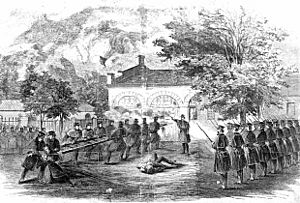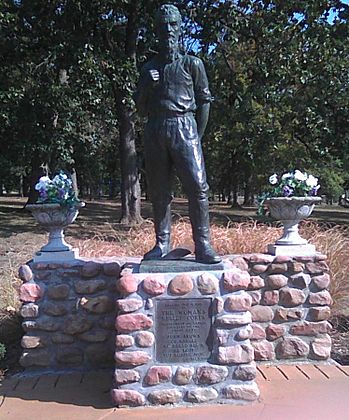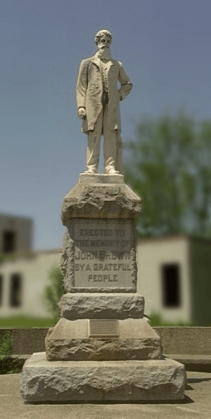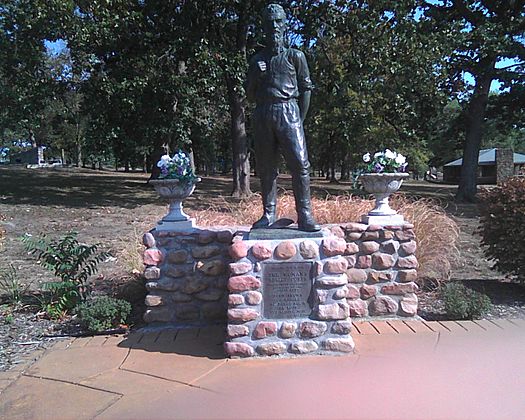John Brown (abolitionist) facts for kids
Quick facts for kids
John Brown
|
|
|---|---|
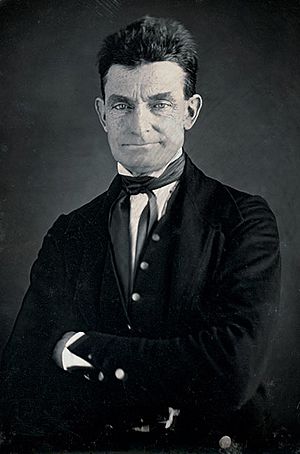
Photo by Augustus Washington, c. 1846–1847
|
|
| Born | May 9, 1800 Torrington, Connecticut, U.S.
|
| Died | December 2, 1859 (aged 59) Charles Town, Virginia (now West Virginia), U.S.
|
| Cause of death | Execution by hanging |
| Resting place | North Elba, New York, U.S. |
| Monuments |
Various:
Statues in Kansas City, Kansas, and North Elba, New York; Tragic Prelude, mural in the Kansas State Capitol; John Brown Farm State Historic Site, North Elba, New York; John Brown Museum and John Brown Historic Park, Osawatomie, Kansas; Museum and Statue, Akron, Ohio; John Brown Tannery Site, Guys Mills, Pennsylvania
|
| Known for | Involvement in Bleeding Kansas; Raid on Harpers Ferry, Virginia. |
| Movement | Abolitionism |
| Criminal charge(s) | Treason against the Commonwealth of Virginia; murder; inciting slave insurrection |
| Spouse(s) |
Dianthe Lusk
(m. 1820; |
| Children | 20, including John Jr., Owen, and Watson |
| Parent(s) | Owen Brown (father) |
| Signature | |
John Brown (May 9, 1800 – December 2, 1859) was an American abolitionist. An abolitionist is someone who wanted to end slavery. Brown believed that using violence was the only way to stop slavery.
He first became well-known during the "Bleeding Kansas" crisis in 1856. In October 1859, Brown led an attack on a federal armory in Harpers Ferry, Virginia (now West Virginia). He hoped to start a movement to free enslaved people. He wanted to give them weapons from the armory. However, only a few enslaved people joined his attack.
Within 36 hours, local farmers, soldiers, and U.S. Marines stopped Brown's men. Many of Brown's men were killed or captured. Brown was later executed by hanging on December 2, 1859. He was found guilty of acting against the state of Virginia. John Brown is still a controversial person today. Some people see him as a hero who died for a good cause. Others see him as a dangerous person who used violence.
Contents
Early Life and Beliefs
John Brown was born on May 9, 1800, in Torrington, Connecticut. He was one of eight children. His family moved to Hudson, Ohio, in 1805. His father, Owen Brown, was a successful businessman. He was also against slavery. Owen Brown even provided a safe house for enslaved people escaping on the Underground Railroad.
When John was 12, he saw an enslaved boy being badly treated. This event deeply affected him. It made him decide to dedicate his life to helping African Americans. At 16, Brown left home to continue his studies.
Family Life
In 1820, John Brown married Dianthe Lusk. They had seven children together. Dianthe died in 1832. Only four of their children lived to be adults.
In 1833, Brown married Mary Ann Day. She was 17 years old. They had 13 children together. Seven of their sons later joined their father in the fight against slavery.
Fighting Against Slavery
Helping Enslaved People Escape
In 1825, Brown moved his family to New Richmond, Pennsylvania. He bought land and built a tannery. A tannery is a place where animal hides are made into leather. His tannery had a secret room. This room was used to hide enslaved people who were escaping to freedom.
This site, known as the John Brown Tannery Site, was an important stop on the Underground Railroad. It is believed that Brown helped about 2,500 enslaved people escape between 1825 and 1835.
Events in Kansas
In 1855, Brown moved to Kansas Territory. Some of his sons were already living there. They needed his help to fight people from Missouri. These people wanted slavery to be legal in Kansas.
On May 24, 1856, Brown and his sons killed five people in Kansas. These people supported slavery. This event became known as the Pottawatomie massacre. It shocked many people and led to more violence. This period in Kansas was called "Bleeding Kansas" because of all the fighting. Brown's son Frederick was killed in a battle on August 30, 1856.
The Harpers Ferry Raid
In 1859, John Brown planned to attack the Harpers Ferry Armory in Harper's Ferry, Virginia. An armory is a place where weapons are stored. Brown planned to take the weapons and give them to enslaved people. He hoped they would use the weapons to fight for their freedom.
Brown attacked the armory in October 1859. His sons and other men, including several African American men, helped him. But his attack failed. Brown was captured. He was later executed by hanging on December 2, 1859. He was found guilty of acting against the state of Virginia.
Death and What Happened Next
On the morning of December 2, 1859, John Brown wrote a final message. He said that the problems of slavery in the country would only be solved with bloodshed. He also wrote a last letter to his wife.
At 11:00 a.m., he was taken from jail to the gallows. The gallows is a structure used for hanging. Many soldiers were there, including future Confederate general Stonewall Jackson. The poet Walt Whitman later wrote about watching the execution.
Brown was buried at his farm in North Elba, New York. His wife took his body there, and he was buried on December 8.
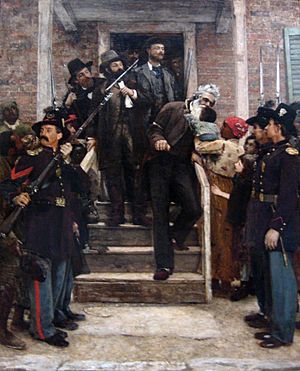

After the Raid
Many people believe that the Harpers Ferry raid helped push the United States closer to the American Civil War. Slave owners in the South worried that other abolitionists would try to start slave rebellions. This led them to strengthen their local armies, which later became part of the Confederate army.
Many abolitionists in the North saw Brown as a martyr. A martyr is someone who dies for a cause they believe in. They felt he sacrificed himself to fight against the evils of slavery. William Lloyd Garrison, a famous abolitionist, said that Brown's raid was "unwise" but defended Brown's character.
After the Civil War, Frederick Douglass, a former enslaved person and abolitionist, said that Brown's dedication to freeing enslaved people was even greater than his own. He said, "I could live for the slave, but he could die for him."
What People Thought of John Brown
People had very strong feelings about John Brown. Some thought he was crazy or evil. Others saw him as a hero. His attack on Harpers Ferry helped lead to the American Civil War, which began in 1861.
Many important Black leaders of that time knew and respected Brown. These included Martin Delany, Henry Highland Garnet, Frederick Douglass, and Harriet Tubman. Harriet Tubman, who helped many enslaved people escape, said Brown was "the greatest white man who ever lived." Douglass called him "a brave and glorious old man."
On the day Brown was executed, Black businesses in the North closed. Church bells rang across the North.
Famous Quotes by John Brown
- "I cannot remember a night so dark as to have hindered the coming day."
- "Caution, Sir! I am eternally tired of hearing that word 'caution.' It is nothing but the word of cowardice!"
- "Holiness...consists in thinking as God thinks and willing as God wills."
- "These men are all talk. What is needed is action - action!"
- "I bring you one of the best and bravest persons on this continent — General Tubman as we call her."
- "Had I so interfered in behalf of the rich, the powerful, the intelligent, the so-called great... every man in this court would have deemed it an act worthy of reward rather than punishment."
- In 1837, Brown promised: "Here, before God, with witnesses around me, from now on, I dedicate my life to the destruction of slavery!"
Places to Remember John Brown
-
Statue of Brown in front of the John Brown Museum, Osawatomie, Kansas
-
Life-size white marble statue of John Brown in Quindaro Townsite, Kansas
Museums and Historic Sites
- John Brown Museum, Harpers Ferry National Historical Park, Harpers Ferry, West Virginia
- John Brown Farm State Historic Site, North Elba, New York
- John Brown Farm, Tannery & Museum, Guys Mills, Pennsylvania
- John Brown House (Chambersburg, Pennsylvania)
- John Brown Museum, Osawatomie, Kansas
- John Brown Raid Headquarters (Kennedy Farm), Samples Manor, Maryland
Most of these museums are places where Brown lived or stayed.
Interesting Facts About John Brown
- John Brown believed that all people should be treated equally, no matter their skin color. Many white Christians in America at this time did not agree with this idea.
- Brown knew the Bible very well. He could even find small mistakes when someone recited it.
- After the Bible, his favorite books were Plutarch's Lives. He also enjoyed reading about Napoleon and Cromwell.
- He never used tobacco or drank tea, coffee, or alcohol.
- In 1829, some white families asked Brown to help them remove Native Americans from the area. Brown refused. He said he would rather help remove the white families. Throughout his life, Brown had good relationships with his Native American neighbors. He sometimes went hunting with them and invited them to eat in his home.
- Many American poets have written poems about him, including John Greenleaf Whittier, Louisa May Alcott, and Walt Whitman.
- He was seen as a hero in the North. Soldiers from the Union army marched to a new song called "John Brown's Body". This song showed him as a heroic figure.
Related pages
Images for kids
-
The John Brown Tannery Site, where Brown's tannery once stood in Pennsylvania
-
John Brown's Farm, North Elba, New York
-
William Maxon's house, near Springdale, Iowa, where John Brown's friends lived and trained, 1857–1859.
-
Portrait of John Brown by Ole Peter Hansen Balling, 1872
See also
 In Spanish: John Brown para niños
In Spanish: John Brown para niños


